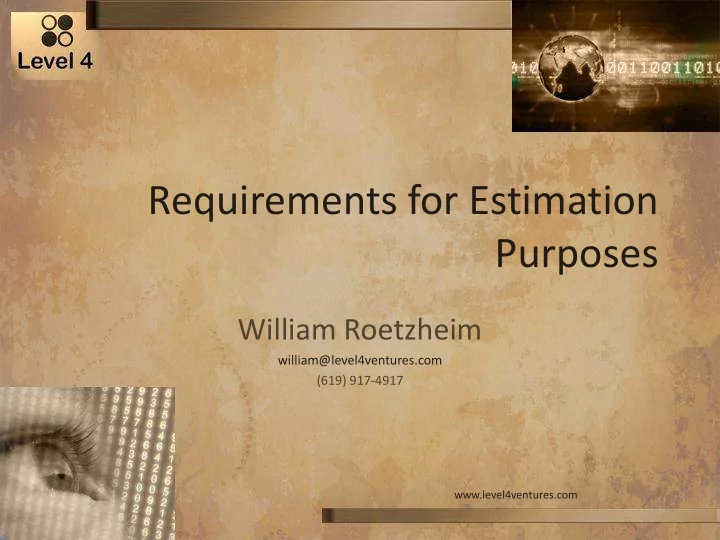

Requirements for Estimation Purposes William Roetzheim william@level4ventures.com (619) 917-4917 www.level4ventures.com 1
Instructor Introduction Mr. William H. Roetzheim Lead Scientist, Founder & CEO, Level 4 Ventures, Inc. Leader in IT project modeling. Developed CostXpert. Co-Founded CostXpert Group. Author of ultiple books, articles and columns. Regular lecturer at industry conferences. Extensive industry and government benchmark data. Education: MBA-University of La Verne, BA-University of Illinois. Certifications: PMI Certified Project Management Professional (PMP), Risk Management Professional (RMP), IFPUG Certified Function Point Counter, SCEA & ISPA Certified Cost Estimation Analyst (CCEA), ISACA Certified in Risk and Information Systems Control (CRISC), ISACA Certified Information System Auditor (CISA). www.level4ventures.com 2
Agenda • Estimation concepts. • Focused requirement analysis. • Requirement analysis process. • Supporting data elements. • Cost analysis requirement document (CARD). • Tips and Tricks. www.level4ventures.com 3
Estimation concepts • Good estimates are: – Accurate. – Comprehensive. – Credible. – Replicable and Auditable. – Timely. – Traceable. Source: International Cost Estimating and Analysis Association (ICEAA) www.level4ventures.com 4
Estimation concepts • Cost estimating cannot: – Be applied with cookbook precision. – Produce results that are better than input data. • Garbage In, Garbage Out (GIGO). – Predict political impacts. – Substitute for sound judgment, management, or control. – Make final decisions. Source: International Cost Estimating and Analysis Association (ICEAA) www.level4ventures.com 5
Estimation Concepts • Determine estimate purpose. • Define estimate boundaries: – Scope, time, exclusions, constraints. – Note that the estimate boundaries may be different from the project boundaries. • If needed, create an estimate WBS: – Breakdown to apply estimation techniques. – Breakdown to support analysis and what-if. – Breakdown to support acquisition. – Breakdown to support Earned Value Management. – Estimation often aligns with control points in the WBS. www.level4ventures.com 6
Estimation Concepts • Estimation approaches and applicability: – Catalog look-up. – Learning curve. – Analogy. – Parametric: • High level. • Parameterized catalog (High Level Objects, or HLOs). – Bottom-up. www.level4ventures.com 7
Progressive Elaboration Scope Scope Scope Change Scope Definition Planning Elaboration Control Progressively Elaborated Baseline Scope Verification www.level4ventures.com 8
Focused requirement analysis • Three levels of requirement definition: – Business goals and objectives. – High level business requirements. – Technical requirements. www.level4ventures.com 9
Focused Requirement Analysis • Characteristics of good high level business requirements: – Unifying: Understandable to both business and technical stakeholders. – Deliverable focused, not activity focused. – Comprehensive: Capture all required delivered functionality. – Unique: Avoid redundancy. – Aligned: Provide an access point into the estimation methodology. www.level4ventures.com 10
Focused Requirement Analysis • Requirement components (may be inferred): – What must be delivered? How many? – Is this capability new, additional, enhanced, test only, or a repair? – How complicated or difficult is the thing being delivered? • For counts larger than 30, the central limit theorem can be applied and the values set to average. – As a minimum, high level requirements must form a basis for making informed assumptions about these elements. www.level4ventures.com 11
Focused Requirement Analysis Some Estimation Catalogs SAP Demo-Financial IVR Other or Unknown Unknown Admin Screen Batch Batch/Service Call Initiation Business Requirement Business Requirement Call Tree Option Configuration Configuration Interface Defect Consulting-Configuration Report Development Consulting-Other Security Profile Interface Consulting-Performance Table Report Consulting-Security Voice Message Screen Interface Other IVR Work Table Page Workflow Report Deployment Software Application Workflows Other Agile FFP UML Stories Screens Scenarios External Interface Files Class-Control Reports Class-Interface Messages Class-Other Logical Internal Tables Tables Methods www.level4ventures.com 12
Requirement analysis process Collect Documents Triage Documents Review Documents Start Estimation Worksheet Obtain Follow-Up Documentation Kick-Off Interview Conduct Follow-Up Interviews www.level4ventures.com 13
Supporting Data Elements Normally required: May be optional: • • Business goals and Work effort (project, blueprint, build, prototype, etc.). objectives. • Estimator. • Benefit streams over • Required environments, tier level, time. application layer load, data layer load, services/interfaces load. • Project descriptors (cost • Meeting notes. center, objective, region, • Estimation related points of contact. etc.). • Impacted applications/components. • Impacted work groups or contractors. www.level4ventures.com 14
Cost analysis requirement document (CARD) • Collects together the basis of the estimate. • Value: – Credible. – Replicable and Auditable. – Traceable. – Supports updates to the estimate. www.level4ventures.com 15
Tips and Tricks • Team interview techniques. • Estimating versus designing. • Use the “sniff test,” but only at the end. • When validating, focus on hands-on time at the component level. • Accuracy versus precision. • The wisdom of crowds. www.level4ventures.com 16
Some case studies • State of California • Procter and Gamble • Top 10 bank www.level4ventures.com 17
Project Risk Management Identify Qualitative Quantitative Risk Response Risks Analysis Analysis Planning Contingency Risk Response Funds Funds Estimate Budget Management Reserve www.level4ventures.com 18
Interview Workshop www.level4ventures.com 19
Questions? Feedback? william@level4ventures.com (619) 917-4917 www.level4ventures.com 20
Recommend
More recommend